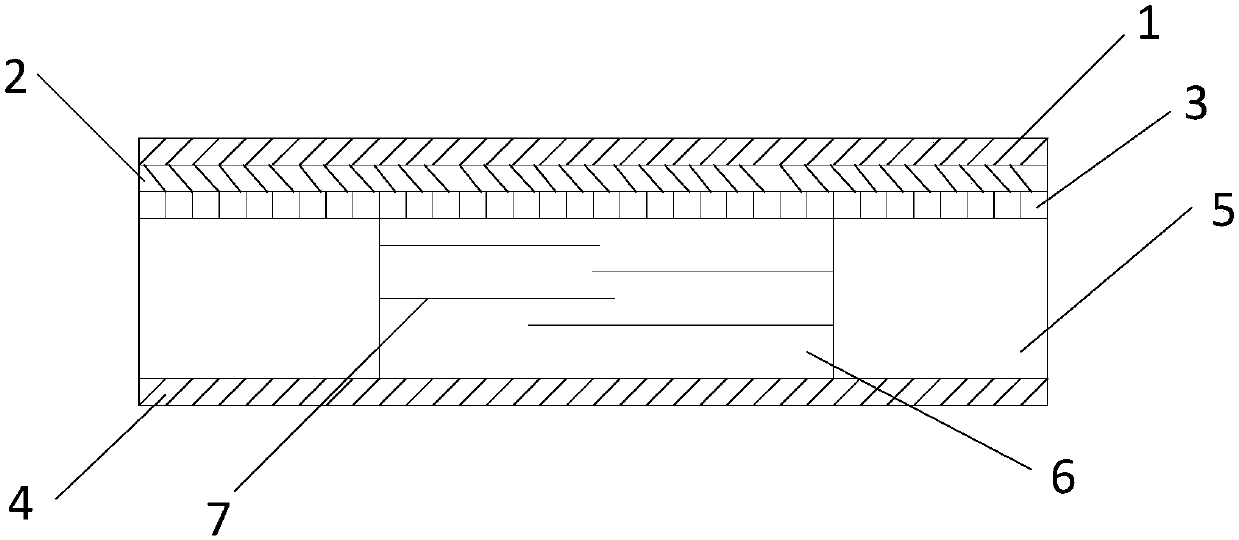Sand-plastic partition wall with sound attenuation function
A partition wall and sand-plastic technology, applied to walls, building components, buildings, etc., can solve the problems of less research on purifying gas, achieve good noise reduction effect, improve overall uniformity, and avoid agglomeration
- Summary
- Abstract
- Description
- Claims
- Application Information
AI Technical Summary
Problems solved by technology
Method used
Image
Examples
Embodiment 1
[0051] This embodiment provides a method for preparing sand-plastic panels, including:
[0052] (1) Negative ion powder and deionized water are mixed according to the mass ratio of 1:10, and the temperature of the water bath is 40°C, and the water bath is ultrasonicated for 10 minutes to obtain the negative ion excitation material slurry;
[0053] (2) Select magnesium-aluminum spinel with a particle size of 2mm, spray aluminum sol on the surface of magnesium-aluminum spinel, so that aluminum sol is evenly coated on the outer surface of magnesium-aluminum spinel, and then spray negative ion excitation material slurry, Dry at 200°C to obtain negative ion generating materials;
[0054] In the negative ion generating material, the mass ratio of magnesium aluminum spinel to negative ion powder is 80:1; the consumption of described aluminum sol is 5% of magnesium aluminum spinel quality;
[0055] (2) Take by weighing 25Kg of quartz sand, 5Kg of negative ion generating material, 15K...
Embodiment 2
[0062] This embodiment provides a method for preparing sand-plastic panels, including:
[0063] (1) Negative ion powder and deionized water are mixed according to the mass ratio of 1:10, and the temperature of the water bath is 40°C, and the water bath is ultrasonicated for 10 minutes to obtain the negative ion excitation material slurry;
[0064] (2) Select magnesium-aluminum spinel with a particle size of 3mm, spray aluminum sol on the surface of magnesium-aluminum spinel, so that aluminum sol is evenly coated on the outer surface of magnesium-aluminum spinel, and then spray negative ion excitation material slurry, Dry at 250°C to obtain negative ion generating materials;
[0065] In the negative ion generating material, the mass ratio of magnesium aluminum spinel to negative ion powder is 80:4; the amount of aluminum sol is 5% of the mass of magnesium aluminum spinel;
[0066] (3) Weigh 35Kg of quartz sand, 7Kg of negative ion generating material, 20Kg of polypropylene res...
Embodiment 3
[0073] This embodiment provides a method for preparing sand-plastic panels, including:
[0074] (1) Mix nano-tourmaline and deionized water according to the mass ratio of 1:10, and at a water bath temperature of 40° C., ultrasonicate the water bath for 10 minutes to obtain a negative ion excitation material slurry;
[0075] (2) Select magnesium-aluminum spinel with a particle size of 5mm, and spray the aluminum sol on the surface of the magnesium-aluminum spinel in a sugar coating machine, so that the aluminum sol is evenly coated on the outer surface of the magnesium-aluminum spinel, and then spray Negative ion excitation material slurry is dried at 300°C to obtain negative ion generating material;
[0076] In the negative ion generating material, the mass ratio of magnesium-aluminum spinel to nano-tourmaline is 100:1; the amount of aluminum sol is 5% of the mass of magnesium-aluminum spinel;
[0077] (3) Weigh 30Kg of quartz sand, 6Kg of negative ion generating material, 19...
PUM
| Property | Measurement | Unit |
|---|---|---|
| particle diameter | aaaaa | aaaaa |
| bending strength | aaaaa | aaaaa |
| impact strength | aaaaa | aaaaa |
Abstract
Description
Claims
Application Information
 Login to View More
Login to View More - R&D
- Intellectual Property
- Life Sciences
- Materials
- Tech Scout
- Unparalleled Data Quality
- Higher Quality Content
- 60% Fewer Hallucinations
Browse by: Latest US Patents, China's latest patents, Technical Efficacy Thesaurus, Application Domain, Technology Topic, Popular Technical Reports.
© 2025 PatSnap. All rights reserved.Legal|Privacy policy|Modern Slavery Act Transparency Statement|Sitemap|About US| Contact US: help@patsnap.com


